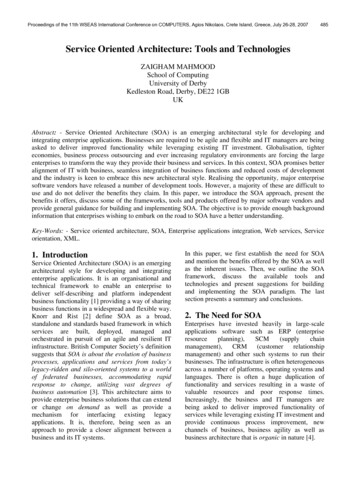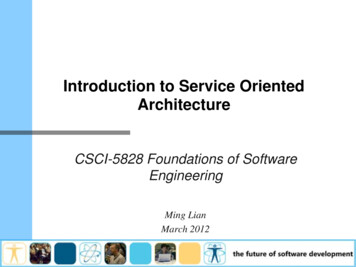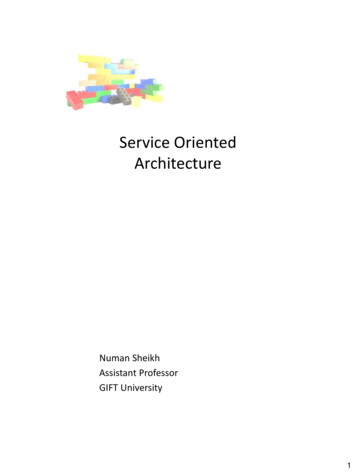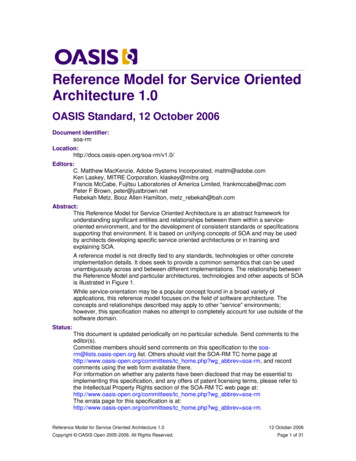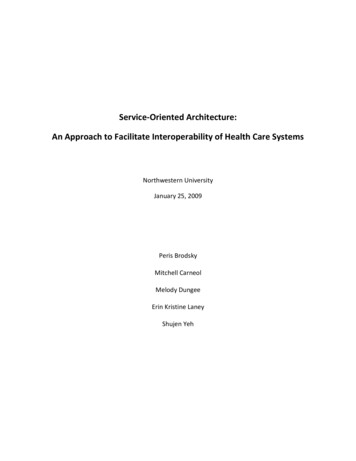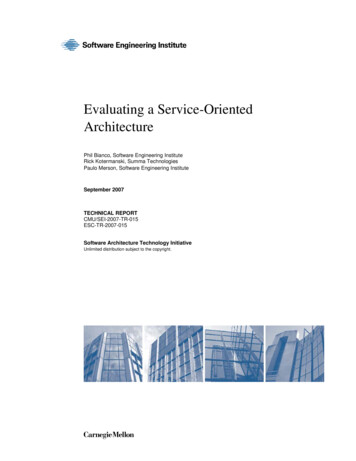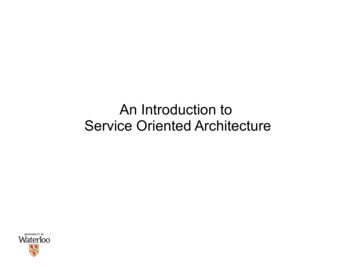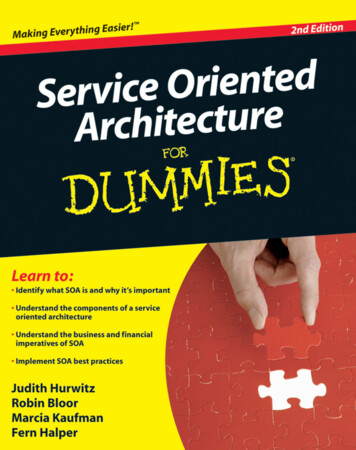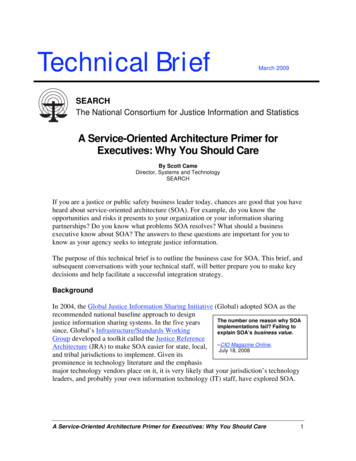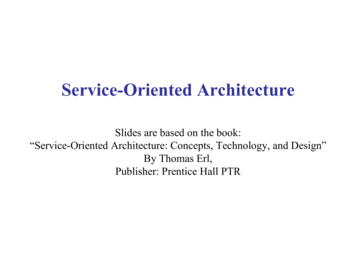
Transcription
Service-Oriented ArchitectureSlides are based on the book:“Service-Oriented Architecture: Concepts, Technology, and Design”By Thomas Erl,Publisher: Prentice Hall PTR
“Because the term "service-oriented" has existed forsome time, it has been used in different contexts andfor different purposes. One constant through itsexistence has been that it represents a distinctapproach for separating concerns. What this means isthat logic required to solve a large problem can bebetter constructed, carried out, and managed if it isdecomposed into a collection of smaller, relatedpieces. Each of these pieces addresses a concern or aspecific part of the problem. This approach transcends technology and automationsolutions. It is an established and generic theory thatcan be used to address a variety of problems. Whatdistinguishes the service-oriented approach toseparating concerns is the manner in which itachieves separation.”
“Service-oriented architecture spans both enterprise andapplication architecture domains. The benefit potential offeredby SOA can only be truly realized when applied acrossmultiple solution environments. This is where the investmentin building reusable and interoperable services based on avendor-neutral communications platform can fully beleveraged. This does not mean that the entire enterprise mustbecome service-oriented. SOA belongs in those areas that havethe most to gain from the features and characteristics itintroduces. Note that the term "SOA" does not necessarily imply aparticular architectural scope. An SOA can refer to anapplication architecture or the approach used to standardizetechnical architecture across the enterprise. Because of thecomposable nature of SOA (meaning that individualapplication-level architectures can be comprised of differentextensions and technologies), it is absolutely possible for anorganization to have more than one SOA.”
Though we encourage independence within our businessoutlets, we must still ensure that they agree to adhere to certainbaseline conventions for example, a common currency for theexchange of goods and services, a building code that requiressignage to conform to certain parameters or perhaps arequirement that all employees speak the same language as thenative consumers. These conventions standardize key aspects ofeach business for the benefit of the consumers withoutsignificantly imposing on the individual business's ability toexercise self-governance. Similarly, service-oriented architecture (SOA) encouragesindividual units of logic to exist autonomously yet not isolatedfrom each other. Units of logic are still required to conform to aset of principles that allow them to evolve independently, whilestill maintaining a sufficient amount of commonality andstandardization. Within SOA, these units of logic are known asservices.
How services encapsulate logic To retain their independence, services encapsulatelogic within a distinct context. This context can bespecific to a business task, a business entity, or someother logical grouping. The concern addressed by a service can be small orlarge. Therefore, the size and scope of the logicrepresented by the service can vary. Further, servicelogic can encompass the logic provided by otherservices. In this case, one or more services arecomposed into a collective.
How services relate Within SOA, services can be used by other services or otherprograms. Regardless, the relationship between services is based onan understanding that for services to interact, they must be aware ofeach other. This awareness is achieved through the use of servicedescriptions. A service description in its most basic format establishes the nameof the service and the data expected and returned by the service. Themanner in which services use service descriptions results in arelationship classified as loosely coupled. For example, Next figureillustrates that service A is aware of service B because service A isin possession of service B's service description. For services to interact and accomplish something meaningful, theymust exchange information. A communications framework capableof preserving their loosely coupled relationship is therefore required.One such framework is messaging.
How services communicate After a service sends a message on its way, it losescontrol of what happens to the message thereafter. That is why we require messages to exist as"independent units of communication." This means that messages, like services, should beautonomous. To that effect, messages can be outfitted with enoughintelligence to self-govern their parts of theprocessing logic.
How services are designed Much like object-orientation, serviceorientation has become a distinct designapproach which introduces commonlyaccepted principles that govern the positioningand design of our architectural components.
How services are designed The application of service-orientation principles to processinglogic results in standardized service-oriented processing logic.When a solution is comprised of units of service-orientedprocessing logic, it becomes what we refer to as a serviceoriented solution. For the purpose of providing a preliminary introduction, let'shighlight some of the key aspects of these SOA principleshere:– Loose coupling Services maintain a relationship thatminimizes dependencies and only requires that they retainan awareness of each other.– Service contract Services adhere to a communicationsagreement, as defined collectively by one or more servicedescriptions and related documents.
How services are designed– Autonomy Services have control over the logic theyencapsulate.– Abstraction Beyond what is described in the servicecontract, services hide logic from the outside world.– Reusability Logic is divided into services with theintention of promoting reuse.– Composability Collections of services can be coordinatedand assembled to form composite services.– Statelessness Services minimize retaining informationspecific to an activity.– Discoverability Services are designed to be outwardlydescriptive so that they can be found and assessed viaavailable discovery mechanisms.
How services are designed With a knowledge of the components that comprise our basicarchitecture and a set of design principles we can use to shapeand standardize these components, all that is missing is animplementation platform that will allow us to pull these piecestogether to build service-oriented automation solutions. The Web services technology set offers us such a platform.With a knowledge of the components that comprise our basicarchitecture and a set of design principles we can use to shapeand standardize these components, all that is missing is animplementation platform that will allow us to pull these piecestogether to build service-oriented automation solutions. TheWeb services technology set offers us such a platform.
How services are built As we mentioned earlier, the term "service-oriented" andvarious abstract SOA models existed before the arrival of Webservices. However, no one technology advancement has been sosuitable and successful in manifesting SOA than Web services. All major vendor platforms currently support the creation ofservice-oriented solutions, and most do so with theunderstanding that the SOA support provided is based on theuse of Web services. Therefore, while we fully acknowledge that achieving SOAdoes not require Web services, the focus is on how SOA canand should be realized through the use of the Web servicestechnology platform.
Primitive SOA The past few sections have described the individualingredients for what we call primitive SOA. It is labeled as such because it represents a baseline technologyarchitecture that is supported by current major vendorplatforms. All forms of SOA we explore from here on are based on andextend this primitive model. Some of the extensions wediscuss are attainable today through the application ofadvanced design techniques, while others rely on theavailability of pre-defined Web services specifications andcorresponding vendor support. Refer: case study 01
Summary of Key Points SOA and service-orientation are implementationagnostic paradigms that can be realized with anysuitable technology platform. Our primitive SOA model represents a mainstreamvariation of SOA based solely on Web services andcommon service-orientation principles. Throughout the discussions, any reference to the term"SOA" implies the primitive SOA model.
Common characteristics ofcontemporary SOA Major software vendors are continually conceiving new Webservices specifications and building increasingly powerfulXML and Web services support into current technologyplatforms. The result is an extended variation of service-orientedarchitecture we refer to as contemporary SOA. Contemporary SOA builds upon the primitive SOA model byleveraging industry and technology advancements to further itsoriginal ideals. Though the required implementationtechnology can vary, contemporary SOAs have evolved to apoint where they can be associated with a set of commoncharacteristics.
Common characteristics ofcontemporary SOASpecifically, we explore the following primary characteristics: Contemporary SOA is at the core of the service-orientedcomputing platform. Contemporary SOA increases quality of service. Contemporary SOA is fundamentally autonomous. Contemporary SOA is based on open standards. Contemporary SOA supports vendor diversity. Contemporary SOA fosters intrinsic interoperability. Contemporary SOA promotes discovery. Contemporary SOA promotes federation.
Common characteristics ofcontemporary SOA Contemporary SOA promotes architecturalcomposability. Contemporary SOA fosters inherent reusability. Contemporary SOA emphasizes extensibility. Contemporary SOA supports a service-orientedbusiness modeling paradigm. Contemporary SOA implements layers of abstraction. Contemporary SOA promotes loose couplingthroughout the enterprise. Contemporary SOA promotes organizational agility.
Common characteristics ofcontemporary SOA Contemporary SOA is a building block.Contemporary SOA is an evolution.Contemporary SOA is still maturing.Contemporary SOA is an achievable ideal.
Contemporary SOA is at the core of the serviceoriented computing platform Many argue that the manner in which SOA is used toqualify products, designs, and technologies elevatesthis term beyond one that simply relates toarchitecture. SOA, some believe, has become synonymous with anentire new world application computing platform. Because we positioned contemporary SOA as buildingupon and extending the primitive SOA model, wealready have a starting point for our definition: Contemporary SOA represents an architecture thatpromotes service-orientation through the use of Webservices.
Contemporary SOA is at the core of the serviceoriented computing platform With SOA, however, the actual acronym has become amulti-purpose buzzword used frequently whendiscussing an application computing platformconsisting of Web services technology and serviceorientation principles. Because the acronym already represents the word"architecture" we are unfortunately subjected tostatements that can be confusing. Perhaps the best way to view it is that if a product,design, or technology is prefixed with "SOA," it issomething that was (directly or indirectly) created insupport of an architecture based on service-orientationprinciples.
Contemporary SOA increasesquality of service There is a definite need to bring SOA to a pointwhere it can implement enterprise-level functionalityas safely and reliably as the more establisheddistributed architectures already do. This relates to common quality of servicerequirements, such as: The ability for tasks to be carried out in a secure manner,protecting the contents of a message, as well as access toindividual services. Allowing tasks to be carried out reliably so that messagedelivery or notification of failed delivery can beguaranteed.
Contemporary SOA increasesquality of service Performance requirements to ensure that the overheadimposed by SOAP message and XML content processingdoes not inhibit the execution of a task. Transactional capabilities to protect the integrity of specificbusiness tasks with a guarantee that should the task fail,exception logic is executed. Contemporary SOA is striving to fill the QoS gaps ofthe primitive SOA model. Many of the concepts andspecifications will be discussed in “SOA and WS-*Extensions”, which provide features that directlyaddress quality of service requirements. For lack of a better term, we'll refer to an SOA thatfulfills specific quality of service requirements as"QoS-capable."
Contemporary SOA isfundamentally autonomous The service-orientation principle of autonomy requires thatindividual services be as independent and self-contained aspossible with respect to the control they maintain over theirunderlying logic. This is further realized through message-level autonomy wheremessages passed between services are sufficiently intelligenceheavy that they can control the manner in which they areprocessed by recipient services. SOA builds upon and expands this principle by promoting theconcept of autonomy throughout solution environments andthe enterprise. Applications comprised of autonomousservices, for example, can themselves be viewed as composite,self-reliant services that exercise their own self-governancewithin service-oriented integration environments.
Contemporary SOA isfundamentally autonomous Later we explain how by creating serviceabstraction layers, entire domains of solutionlogic can achieve control over their respectiveareas of governance. This establishes a level of autonomy that cancross solution boundaries.
Contemporary SOA is based onopen standards Perhaps the most significant characteristic of Web services isthe fact that data exchange is governed by open standards.After a message is sent from one Web service to another ittravels via a set of protocols that is globally standardized andaccepted. Further, the message itself is standardized, both in format andin how it represents its payload. The use of SOAP, WSDL,XML, and XML Schema allow for messages to be fully selfcontained and support the underlying agreement that tocommunicate, services require nothing more than a knowledgeof each other's service descriptions. The use of an open, standardized messaging model eliminatesthe need for underlying service logic to share type systems andsupports the loosely coupled paradigm.
Contemporary SOA is based onopen standards Contemporary SOAs fully leverage andreinforce this open, vendor-neutralcommunications framework in the next figure. An SOA limits the role of proprietarytechnology to the implementation and hostingof the application logic encapsulated by aservice. The opportunity for inter-servicecommunication is therefore always an option.
Contemporary SOA supportsvendor diversity The open communications framework explained in theprevious section not only has significant implications forbridging much of the heterogeneity within (and between)corporations, but it also allows organizations to choose bestof-breed environments for specific applications. For example, regardless of how proprietary a developmentenvironment is, as long as it supports the creation of standardWeb services, it can be used to create a non-proprietary serviceinterface layer, opening up interoperability opportunities withother, service-capable applications. This, incidentally, has changed the face of integrationarchitectures, which now can encapsulate legacy logic throughservice adapters, and leverage middleware advancementsbased on Web services.
Contemporary SOA supportsvendor diversity Organizations can certainly continue buildingsolutions with existing development tools and serverproducts. In fact, it may make sense to do so, only tocontinue leveraging the skill sets of in-houseresources. However, the choice to explore the offerings of newvendors is always there. This option is made possibleby the open technology provided by the Web servicesframework and is made more attainable through thestandardization and principles introduced by SOA.
Contemporary SOA promotes discovery Even though the first generation of Web services standardsincluded UDDI, few of the early implementations actuallyused service registries as part of their environments. This mayhave to do with the fact that not enough Web services wereactually built to warrant a registry. However, another likely reason is that the concept of servicediscovery was simply not designed into the architecture. Whenutilized within traditional distributed architectures, Webservices were more often employed to facilitate point-to-pointsolutions. Therefore, discovery was not a common concern. SOA supports and encourages the advertisement and discoveryof services throughout the enterprise and beyond. A seriousSOA will likely rely on some form of service registry ordirectory to manage service descriptions
Registries enable a mechanism for the discovery of services
Contemporary SOA fostersintrinsic interoperability Further leveraging and supporting the required usage of openstandards, a vendor diverse environment, and the availability ofa discovery mechanism, is the concept of intrinsicinteroperability. Regardless of whether an application actually has immediateintegration requirements, design principles can be applied tooutfit services with characteristics that naturally promoteinteroperability. When building an SOA application from the ground up,services with intrinsic interoperability become potentialintegration endpoints. When properly standardized, this leads to service-orientedintegration architectures wherein solutions themselves achieve alevel of intrinsic interoperability. Fostering this characteristiccan significantly alleviate the cost and effort of fulfilling futurecross-application integration requirements.
Intrinsically interoperable services enable unforeseen integrationopportunities
Contemporary SOA promotes federation Establishing SOA within an enterprise does notnecessarily require that you replace what you alreadyhave. One of the most attractive aspects of thisarchitecture is its ability to introduce unity acrosspreviously non-federated environments. While Web services enable federation, SOA promotesthis cause by establishing and standardizing theability to encapsulate legacy and non-legacyapplication logic and by exposing it via a common,open, and standardized communications framework(also supported by an extensive adapter technologymarketplace).
Contemporary SOA promotes federation Obviously, the incorporation of SOA withprevious platforms can lead to a variety ofhybrid solutions. However, the key aspect is that thecommunication channels achieved by this formof service-oriented integration are all uniformand standardized
Services enable standardized federation of disparate legacy systems
Contemporary SOA promotesarchitectural composability Composability is a deep-rooted characteristic of SOA that canbe realized on different levels. For example, by fostering thedevelopment and evolution of composable services, SOAsupports the automation of flexible and highly adaptivebusiness processes. As previously mentioned, services exist asindependent units of logic. A business process can therefore bebroken down into a series of services, each responsible forexecuting a portion of the process. A broader example of composability is represented by thesecond-generation Web services framework that is evolvingout of the release of the numerous WS-* specifications. Themodular nature of these specifications allows an SOA to becomposed of only the functional building blocks it requires.
“Service-oriented architecture spans both enterprise and application architecture domains. The benefit potential offered by SOA can only be truly realized when applied across multiple solution environments. This is where the investment in building reusable and interoperable services based on a

